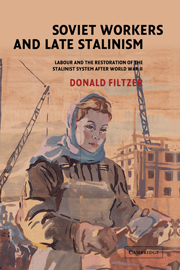 Soviet Workers and Late Stalinism
Soviet Workers and Late Stalinism Book contents
- Frontmatter
- Contents
- List of tables
- Preface and acknowledgements
- List of terms and abbreviations
- Introduction: the political imperatives of the postwar recovery
- 1 Rebuilding the workforce: free, slave, and indentured labour
- 2 The food crisis of 1946–1947
- 3 Attenuated recovery: the end of rationing, housing, and health
- 4 ‘Socializing’ the next generation: the position of young workers
- 5 Labour discipline and criminal law: the futility of repression
- 6 The industrial enterprise: working conditions, work organization, and wage determination
- Conclusion: labour and the ‘renormalization’ of Stalinist social relations
- Bibliography
- Index
5 - Labour discipline and criminal law: the futility of repression
Published online by Cambridge University Press: 07 August 2009
- Frontmatter
- Contents
- List of tables
- Preface and acknowledgements
- List of terms and abbreviations
- Introduction: the political imperatives of the postwar recovery
- 1 Rebuilding the workforce: free, slave, and indentured labour
- 2 The food crisis of 1946–1947
- 3 Attenuated recovery: the end of rationing, housing, and health
- 4 ‘Socializing’ the next generation: the position of young workers
- 5 Labour discipline and criminal law: the futility of repression
- 6 The industrial enterprise: working conditions, work organization, and wage determination
- Conclusion: labour and the ‘renormalization’ of Stalinist social relations
- Bibliography
- Index
Summary
One of the most complicated and little-known aspects of the social history of the Soviet Union in the immediate postwar period was the mass flight of workers from enterprises in industry and construction, and of teenage labour trainees from the Labour Reserve schools. One thing that makes the phenomenon so remarkable was that workers and vocational students abandoned their jobs in the face of extraordinarily harsh penalties which had been introduced during the war: five to eight years in a corrective labour camp for workers in defence-related industry and construction; three to ten years in a camp for workers on transport; and one year in a camp for teenage trainees. Western historians writing in the period before access to the archives was possible had already deduced from oblique references by Soviet labour economists that these sanctions, imposed between 1940 and 1943, had not completely eliminated labour turnover in Soviet factories in the years after World War II. However, the scale on which it occurred turns out to have been far larger than anyone had thought. Spontaneous departure was highest in those sectors of the economy – construction, coal mining, and iron and steel – which were at the core of the Stalinist leadership's programme for postwar industrial reconstruction, and threatened it with serious disruption.
- Type
- Chapter
- Information
- Soviet Workers and Late StalinismLabour and the Restoration of the Stalinist System after World War II, pp. 158 - 200Publisher: Cambridge University PressPrint publication year: 2002


